For many of us the only time we get to enjoy our hobby is at the weekend along with the vast majority of the fishing public. Your favourite lake may be a fair few acres in size with a good head of carp to be caught, however as soon as those spods and baited rigs start hammering into the water the fish can drift off out of harm’s way, normally beyond the range of the average angler’s casting range of 80 yards or so.
Then as we settle down into our fishing session we can see carp showing and jumping at 100-130 yards in the lake quiet zone, too far for most people to reach. At this point many will try valiantly to hit the longer ranges and fail for a multitude of reasons: their rigs may not be suitable for long range casting; it could be their reels are too small to hold sufficient line; or the line is too thick and wiry. The rods may be a low test curve with a soft through players action; or too stiff to the point they can’t compress the blank, or they may just not have a good casting technique. Any combination of the previous issues will have a negative effect on your ability to put a baited rig at range.
Let’s take a little look at the sort of tackle you will need to hit the longer spots, starting with rods.
A good casting rod does not have to have the action of a broom stick but it does need to have a strong butt and mid section and a fast tip recovery. All of these elements mean that during the casting sequence the rod is loaded up in compression, due to the speed of the cast and the weight of the lead. This compression and the rods ability to recover is what imparts the speed into the lead and the speed is what gives you the range.
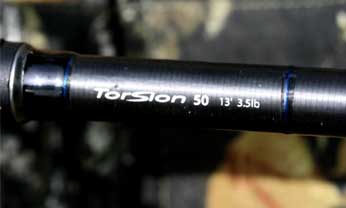 Most carp rods are offered in 12′ variants ranging from 2.75 lb up to 3.5lb test curve. The test curve is an indicator of the weight the rod is best suited to casting. So a 2.75lb TC has an optimum casting weight of between 2.5 oz and 3.25 oz. To achieve the longer range you typically need to be casting a heaver rig of around 3.5oz to 4 oz, so you will need a heavier test curve rod of around 3.25 tc to 3.5 tc.
Most carp rods are offered in 12′ variants ranging from 2.75 lb up to 3.5lb test curve. The test curve is an indicator of the weight the rod is best suited to casting. So a 2.75lb TC has an optimum casting weight of between 2.5 oz and 3.25 oz. To achieve the longer range you typically need to be casting a heaver rig of around 3.5oz to 4 oz, so you will need a heavier test curve rod of around 3.25 tc to 3.5 tc.
Rather than going for a standard 12′ rod try the longer 13′ rod. This will give you a larger casting arc which in turn will give you faster lead speeds which should give you a longer cast. Look for a good name brand if you can. You don’t have to spend £400.00 on rods to be able to get long ranges. My long range rods are the Greys Torsion 13′, 3.5 lb tc with 50mm ringing. They are not cheap but if you want quality you have to pay for it.
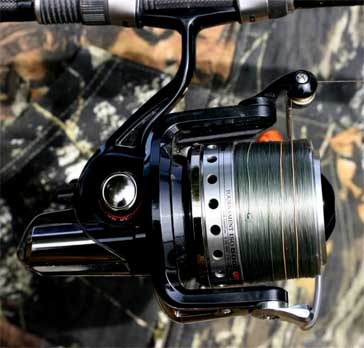 Now you have your rods sorted out, we turn our attention to the reels we will need to use and the line we need. The reel needs to do a number of things like holding line, have a smooth clutch and be able to crank the rig back in again. All reels achieve these requirements but some do it much better than others.
Now you have your rods sorted out, we turn our attention to the reels we will need to use and the line we need. The reel needs to do a number of things like holding line, have a smooth clutch and be able to crank the rig back in again. All reels achieve these requirements but some do it much better than others.
The reel will need to hold enough line so we can cast without the spool emptying quickly and creating line friction by the line hitting the spool lip as it leaves the reel. Choose a reel that has a large spool, preferably metal with a metal line clip. 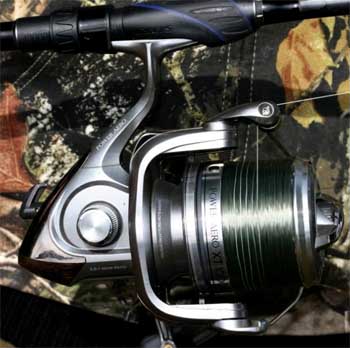 It should have a smooth, easily adjustable clutch, normally front mounted, and low ratio gearing that will allow you to easily retrieve your rig – hopefully with a large carp on the end! Top end reels like the Shimano Poweraero (right) with the new Mk11 Baitrunner Quick clutch or the Diawa Tournament ISO QD (above) both offer quality in abundance and have all the features you require for long range fishing.
It should have a smooth, easily adjustable clutch, normally front mounted, and low ratio gearing that will allow you to easily retrieve your rig – hopefully with a large carp on the end! Top end reels like the Shimano Poweraero (right) with the new Mk11 Baitrunner Quick clutch or the Diawa Tournament ISO QD (above) both offer quality in abundance and have all the features you require for long range fishing.
Before we can choose a line we need to understand a little more about the lake we are going to be fishing in. If the lake is weedy or snaggy, a light low diameter line would not be up to the task, so a thicker, more substantial line is required. However this will reduce the range we can cast. In lakes where we have a clear, snag-free bottom with no gravel bars to abrade the line, we could easily get away with 12lb line. However if it is snaggy, weedy or has gravel bars which the line can rub over, a 16lb line is far better suited to the task.
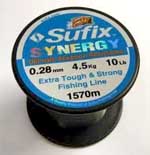 I have been using Sufix synergy recently in 12lb. This line is a smooth, subtle line that sinks well and is easy to knot. The stated line diameter for 12lb is .30mm which makes it very thin making it great for casting. Other good lines to try are Diawa Sensor at the low budget end, and Terry Eustace Pro Clear at the higher value end, both excellent lines.
I have been using Sufix synergy recently in 12lb. This line is a smooth, subtle line that sinks well and is easy to knot. The stated line diameter for 12lb is .30mm which makes it very thin making it great for casting. Other good lines to try are Diawa Sensor at the low budget end, and Terry Eustace Pro Clear at the higher value end, both excellent lines.
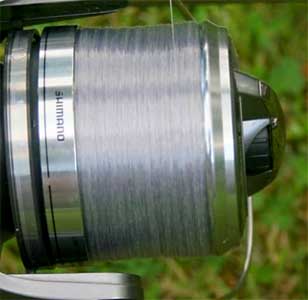 When loading spools with line, make sure you fill the spool so that the line lays parallel to the very top lip or even a little over to ensure you reduce as much as possible the friction of the line as it passes over the spool front lip.
When loading spools with line, make sure you fill the spool so that the line lays parallel to the very top lip or even a little over to ensure you reduce as much as possible the friction of the line as it passes over the spool front lip.
With the line on our reels we now need to consider a leader. This helps transfer all the energy you create in the cast passing to the lead without the line snapping. Many manufacturers make tapered mono leaders offering 45lb – 15lb. These work but have a couple of downfalls. The first is, the 45lb end of the leader is very thick line making the knots you tie in it large and bulky. Also, due to the mono’s ability to stretch, some of the casting energy is lost in the early stages of the cast sequence, as the mono absorbs this energy as line stretch.
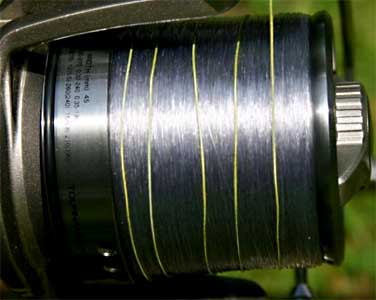 If your venue allows braided leaders, a 45lb or 50lb braid leader meet both of those problems, due to being both very thin and having zero stretch. Connect the leader with either a carrot knot or a simple double grinner and ensure there are about four turns of leader on the reel, with the leader through all of the eyes and your hanging end-rig reaching the butt ring.
If your venue allows braided leaders, a 45lb or 50lb braid leader meet both of those problems, due to being both very thin and having zero stretch. Connect the leader with either a carrot knot or a simple double grinner and ensure there are about four turns of leader on the reel, with the leader through all of the eyes and your hanging end-rig reaching the butt ring.
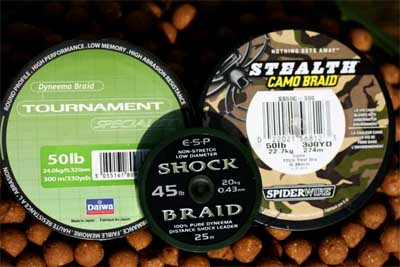
End Rigs
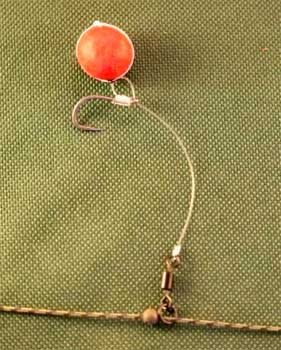 Rigs are next to be looked at. Two great-for-casting rigs come to mind straight away, those being a chod rig and a helicopter rig. These rigs work well due to the lead being presented at the end of the line with the hook length coming off the side of the line. This style of rig reduces the chances of tangles but is not so good when you need to add some attraction to your rig, because the PVA bags can cause the rigs to tangle, both during the cast and as the rig enters the water.
Rigs are next to be looked at. Two great-for-casting rigs come to mind straight away, those being a chod rig and a helicopter rig. These rigs work well due to the lead being presented at the end of the line with the hook length coming off the side of the line. This style of rig reduces the chances of tangles but is not so good when you need to add some attraction to your rig, because the PVA bags can cause the rigs to tangle, both during the cast and as the rig enters the water.
So we need to adapt our rigs for long range fishing. I have three I use to great effect.
The first is a simple helicopter rig based upon a length of lead core leader. I use two Solar 4mm leadcore beads to trap an Atomic quick-change swivel and hook-length on the leadcore. I then add another bead, in which I make a new hole to ensure the bead is tight on the leadcore. I then push a stick-mix stick up the leadcore with a long-gated baiting-needle, finishing off the rig with a Korda sleeve and speed link and distance lead. Pull your hook into the PVA stick and then tighten up the hooklength by pushing the Solar beads up the leadcore. The rig is then ready to go.
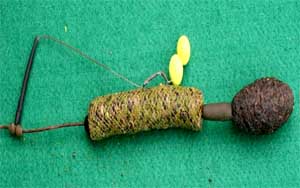
My next rig is a simple PVA bag from the Fishing Bag company. It’s a thick PVA conical bag with an opening in the end. You can use running rigs, side-clips or simple helicopter rigs with this system. This rig will allow you to use the set-up in weedy or snaggy waters where a lead eject (side clip) rig is required, without losing the required aerodynamics. The added benefit of this bag system is, you can use high liquid content mixes in your bags. The bag requires you to use a Zip or Distance lead to correctly block the hole but, once in place and filled with your preferred bait, this tough little bag will cast a very long way in the right hands.
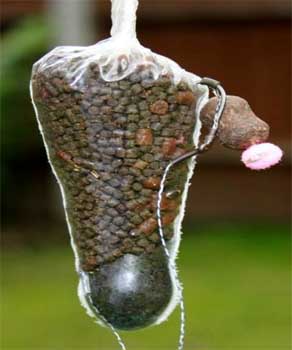
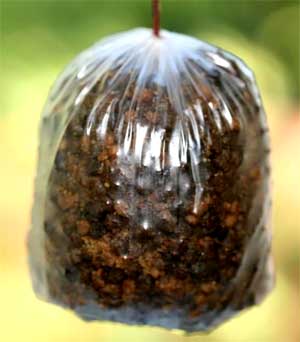
My third rig is a solid doubled long PVA bag fished with either a 3 oz inline running rig, utilising a square pear or (if the situation demands a side-clip/lead eject rig) with a 3 oz flat pear, with the swivel cut off to save room in the bag. A short 3″ or 4″ soft braided hooklength will allow you to insert the rig and hooklength comfortably into the bag. Then fill 1/3 with pellets and next, the rig is placed carefully in the bag.
The hook point is covered by a piece of PVA foam to ensure the rig is protected. It pops out of the bag as soon as it melts, allowing the rig to drop back onto the top of the pellets once the PVA foam nugget has dissolved. The bag is tied tight with PVA tape which will leave a lot of PVA bag material above the bag. This is carefully stretched and pulled back over the existing bag and pulled tight with the excess PVA cut off, leaving enough to stick the outer layer to the inner bag. You should end up with a really neat, tight bag about 50mm in diameter. This double skinned bag is strong enough and small enough to be able to be cast a very long way. It does take a while to set up but it is perfect for its job.
Onto Casting
So now we have all the gear sorted we can now look at casting technique and how to get the best from our tackle.
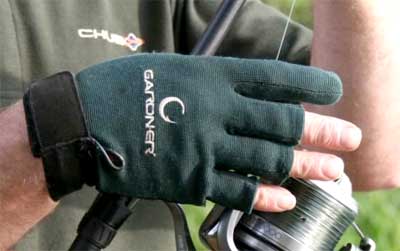 Before we start casting seriously we must ensure our tackle is ready to use so check the rod joints are tight and that the reel seat is also tight. Finally, tighten the clutch. You cannot afford for the clutch to slip during the cast as it can badly burn or cut your fingers. Wear a finger stool or casting glove for extra protection. Make sure your leader knots and rig knots are strong and that there is no damage to the reel line or leader. With the pre-cast check complete, it’s time to have a go at casting to the horizon.
Before we start casting seriously we must ensure our tackle is ready to use so check the rod joints are tight and that the reel seat is also tight. Finally, tighten the clutch. You cannot afford for the clutch to slip during the cast as it can badly burn or cut your fingers. Wear a finger stool or casting glove for extra protection. Make sure your leader knots and rig knots are strong and that there is no damage to the reel line or leader. With the pre-cast check complete, it’s time to have a go at casting to the horizon.
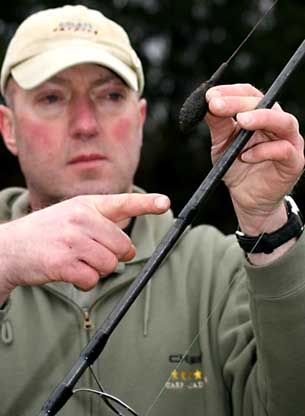 Make sure you have the correct rig drop on your rod. This should position the lead somewhere between the spigot and the first ring on the second section.
Make sure you have the correct rig drop on your rod. This should position the lead somewhere between the spigot and the first ring on the second section.
The majority of anglers I see on the bank will adopt a standard overhead casting technique which, when executed well, should be able to achieve 150 yards plus. However most anglers will cast with arms bent and the rod held close to the body and with the rod at an angle that will only allow them 45 degrees of casting sweep. This is nowhere near enough sweep to get a powerful long range carp rod sufficiently compressed to achieve a long cast.
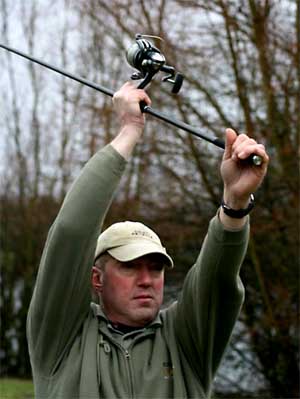 The optimum body position for getting distance from the overhead cast is with straight arms, holding the rod well away from the body, as the picture indicates. This style allows for 100 degrees of casting sweep during the cast, more than double that of the previous short arm style. The right arm holding the rod above your head does nothing but act as a pivot fulcrum with all the power being generated by the left hand as it is pulled down quickly toward the body.
The optimum body position for getting distance from the overhead cast is with straight arms, holding the rod well away from the body, as the picture indicates. This style allows for 100 degrees of casting sweep during the cast, more than double that of the previous short arm style. The right arm holding the rod above your head does nothing but act as a pivot fulcrum with all the power being generated by the left hand as it is pulled down quickly toward the body.
Once ready we are going to use our legs in combination with our arms. You need to use both your legs and body to add a little extra power to the cast.
Once you have your arms upright above your head, lean back a little, putting more weight onto your back leg, with the rig hanging still under the rod and not swinging about. Now, take a slow and steady step forward and whilst doing so, lean forward into the cast. At this point, snap your left arm back into your body. Once the lead is released, keep the rod pointing high, 45 degrees, pointing in the direction of the cast. This will ensure the line leaves the rodrings as efficiently as possible and therefore helps eliminate any additional friction.
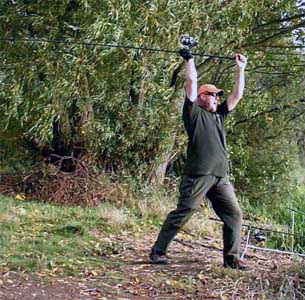
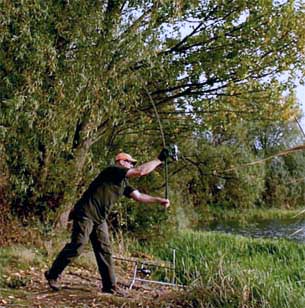
Once the lead has landed, gather the excess line up, dip the rod tip, sink the line under the water and set your rods on the alarms.
The key to achieving long range casting success is getting your tackle optimized and balanced to suit the ranges you are trying to achieve – and to practise your technique until you have it mastered.
Always ensure you are not putting other anglers at risk when you are going for a long chuck. A lead can travel a long way after a crack-off so always think safety first.
Have fun with your long range fishing and use it when you can’t get a bite at close and medium ranges or when the fish are showing at range.
Tight Lines
Ian Gemson Smart Carping Limited










